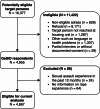Sexual assault experience, depression, and heavy substance use among German adults: an exploratory mediation analysis
- PMID: 40065280
- PMCID: PMC11892163
- DOI: 10.1186/s12889-025-22117-4
Sexual assault experience, depression, and heavy substance use among German adults: an exploratory mediation analysis
Abstract
Background: The experience of sexual assault may be associated with numerous adverse outcomes, including depressive disorders and heavy substance use. We aimed to examine the relationship between heavy substance use and depression in victims of sexual assault.
Methods: We used nationally representative data from the German Health and Sexuality Survey (GeSiD) with N = 4,955 women and men aged 18-75 years. We assessed (i) the potential effect of sexual assault experience on depression mediated through hazardous alcohol, heavy tobacco, and frequent cannabis use and (ii) sexual assault experience on heavy substance use mediated through depression using logistic regression analysis to estimate proportion mediated (PM).
Results: We found some evidence of mediation between sexual assault as a lifetime event and depression by heavy tobacco use (PM = 1.6%) and frequent cannabis use (PM = 14.7%) among women. We also observed mediation by hazardous alcohol use (PM = 35.5%) and heavy tobacco use (PM = 48.6%) among men who experienced childhood sexual assault. Focusing on depression as a potential mediator, we found some evidence of mediation between sexual assault as a lifetime event and heavy tobacco use among women (PM = 17.6%) and men (PM = 13.3%), and between sexual assault as a lifetime event and frequent cannabis use (PM = 26.9%) among women.
Conclusions: Our findings suggest that public health specialists, clinicians, and therapists should develop early interventions to prevent addiction and the development of depression after experiencing sexual assault.
Keywords: Depression; Germany; Mediation analysis; Mental health; Sexual assault; Substance use.
© 2025. The Author(s).
Conflict of interest statement
Declarations. Ethics approval and consent to participate: This study was performed in line with the principles of the Declaration of Helsinki. The Ethics Committee of the State Psychotherapy Chamber in Hamburg approved all the GeSiD procedures (reference: 07/2018-PTK-HH). Every participant included in the study signed informed consent to participate. Consent for publication: Not applicable. Competing interests: The authors declare no competing interests.
Figures
Similar articles
-
Frequent Cannabis Use Moderates the Relationship Between Sexual Dysfunction and Depression Among Female German Adults.J Sex Med. 2022 Jun;19(6):940-949. doi: 10.1016/j.jsxm.2022.03.610. Epub 2022 Apr 14. J Sex Med. 2022. PMID: 35431149
-
Relationships between sexual violence and chronic disease: a cross-sectional study.BMC Public Health. 2014 Dec 16;14:1286. doi: 10.1186/1471-2458-14-1286. BMC Public Health. 2014. PMID: 25516229 Free PMC article.
-
Association Between Adult Sexual Assault and Psychiatric Disorders: Results From the National Epidemiologic Survey on Alcohol and Related Conditions-III.J Clin Psychiatry. 2025 Jun 16;86(3):24m15631. doi: 10.4088/JCP.24m15631. J Clin Psychiatry. 2025. PMID: 40521915
-
Health care utilization and unhealthy behaviors among victims of sexual assault in Connecticut: results from a population-based sample.J Gen Intern Med. 2011 May;26(5):524-30. doi: 10.1007/s11606-010-1614-4. Epub 2011 Jan 8. J Gen Intern Med. 2011. PMID: 21222047 Free PMC article.
-
Sexual assault and substance use in male veterans receiving a brief alcohol intervention.J Stud Alcohol Drugs. 2011 Sep;72(5):693-700. doi: 10.15288/jsad.2011.72.693. J Stud Alcohol Drugs. 2011. PMID: 21906496
References
-
- World Health Organization. Global and regional estimates of violence against women: prevalence and health effects of intimate partner violence and non-partner sexual violence. Geneva: WHO; 2013.
-
- World Health Organization. Violence against women prevalence estimates, 2018. Global, regional and National prevalence estimates for intimate partner violence against women and global and regional prevalence estimates for non-partner sexual violence against women. Geneva: WHO; 2021.
-
- German Federal Centre for Health Education. Youth sexuality: repeat survey of 14–17 year olds and their parents. Cologne: BZgA; 2006.
-
- Krahé B. Sexual aggression and victimization among adolescents and young adults: prevalence and predictors. Psychol Rundsch. 2009;60:173–83.
MeSH terms
LinkOut - more resources
Full Text Sources
Medical



